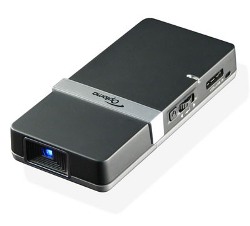Nov 17 2009
TI DLP's Pico chipset will change the way consumers interact with their mobile devices and home electronics, allowing them to share content and experiences with friends and family.
 Optoma PK102 pico projector featuring DLP imaging technology, courtesy of Optoma
Optoma PK102 pico projector featuring DLP imaging technology, courtesy of Optoma
The same Texas Instruments DLP projection technology that lights up cinema screens around the world, delights home theater enthusiasts and is a classroom mainstay across the United States, is making an even bigger impact as it gets smaller; The DLP Pico chipset is capable of projecting images up to 100 inches from a chip with only half the surface area of a postage stamp, and it's poised to have a big impact on the consumer technology market.
The Impact of DLP Pico
The tiny Texas Instruments DLP Pico chipset allows Pico projectors to go where projectors have never been before: Into mobile phones, embedded in personal media players, into ultra-portable projectors the size of a deck of cards.
This shift represents more than just the shrinking of devices; it's a change in how consumers use their personal electronics.
- A traveling businessperson can now carry in their pocket what they used to need a second suitcase for. It allows for impromptu, instant, professional business presentations.
- School districts can put projection capabilities in the palm of the teacher's hand effectively bringing the classroom to any location.
- Friends can shop online together to share ideas and fashions before buying.
- Social media becomes social again, and users can share photos and updates with the friends sitting next to them, as they share them with their friends around the world.
Travelers can share pictures and videos from their trip with each other before they even return home.
Consumers today typically have a 1:1 relationship with their personal electronics. By introducing an embedded Pico projector, DLP Pico technology is enabling consumers to effortlessly share their content and experiences with friends and family.
For more about what Texas Instruments DLP is doing in the Pico space,
DLP's Product Lineup
The latest products on the market featuring the TI DLP Pico chipset represent the wide array of uses for the technology:
- Samsung W7900 Projector Phone
- Optoma PK102 Pico Projector
- Samsung MBP200 Media Player/Personal Media Player
- WowWee Cinemin Swivel Pico Projector
- Dell M109S Notebook Companion Projector
What Does the Future Hold for Pico?
With the increasing range and popularity of devices embedded with DLP Pico projectors, the market for these projectors is forecast for huge growth.
While the market for projectors embedded in mobile phones and media players is clearly a growth opportunity, other markets are showing promise.
One of those markets is digital signage. Christie Digital, a global leader in visual solutions, has used DLP Pico technology to develop MicroTiles, modular digital display tiles that can be stacked and clustered like building blocks to create display walls of any shape or scale. MicroTiles use DLP Pico technology to create an entirely new, advanced optical design that produces unparalleled levels of brightness, contrast and color reproduction.
In 2010, we can expect to see:
- Expansion of DLP Pico projectors into even more devices and categories: More mobile phones, notebook companion projectors and media players, as well as toys and gaming accessories.
- New partnerships with leading manufacturers
Innovating with DLP Pico
Almost as soon as the TI DLP products were on the market, developers and researchers working in areas outside of traditional projection displays began requesting access to DLP technology to fuel their innovative ideas. In response, Texas Instruments developed DLP Discovery kits to enable innovation in the medical, direct imaging, structured lighting and spectroscopy fields, among others.
The DLP Pico Projector Development Kit was created in response to demand from developers and researchers eager to experiment with DLP technology as an alternative to disassembling projectors to gain access to the DLP chipset. The kit combines the imaging power of DLP with a tiny projector form factor to enable innovative mobile projection applications.
The DLP Pico chipset represents a significant innovation for DLP technology. With it, TI is addressing two distinct market categories: consumer-focused products such as cell phones and portable projectors, and non-traditional, high growth markets that require light manipulation.
The resulting application ideas include augmented reality, battery or USB-powered display applications, simple 3D measurement applications, projection of video and images and miniature appliances that don't have space for a large display.
Source: http://www.ti.com/